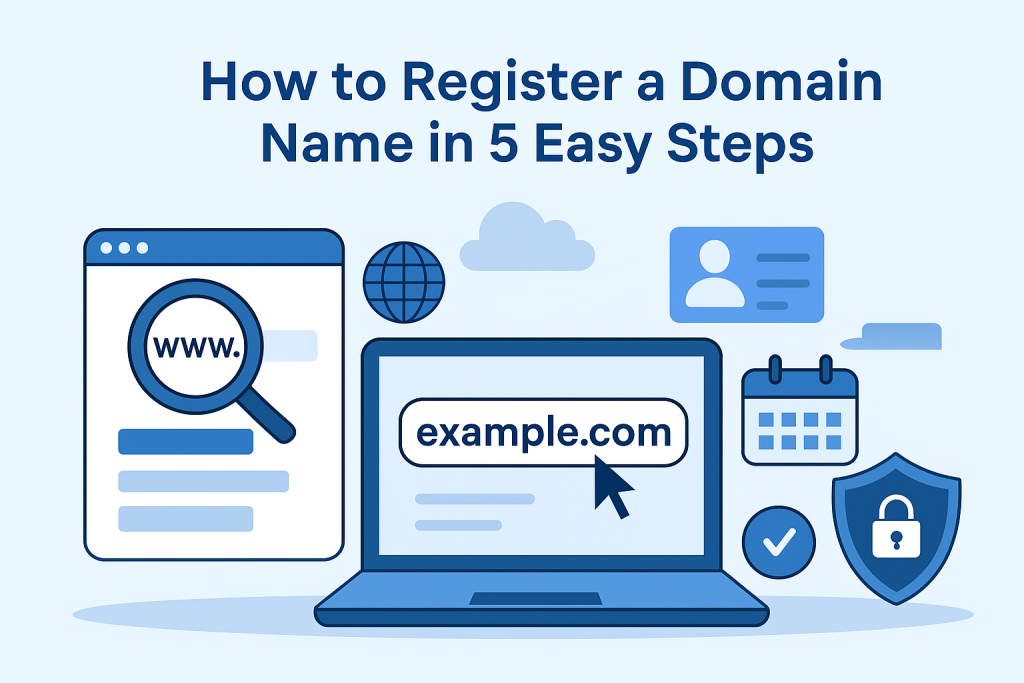Your domain name is the front door to your online presence. Whether you’re launching a blog, building a business website, or starting an online store, securing the right domain name is your first step to digital success.
But domain name registration doesn’t have to be complicated. In fact, with the right guidance, you can secure your perfect domain in just a few simple steps.
Let’s break it down.
Step 1: Choose the Perfect Domain Name
Before you register anything, you need to decide what to register. Your domain name should be:
- Short and memorable
- Easy to spell and type
- Relevant to your brand or niche
- Keyword-rich (when possible)
Tips for Brainstorming:
- Use tools like LeanDomainSearch or NameMesh to generate ideas.
- Include relevant keywords for better SEO.
- Consider alternative TLDs (Top Level Domains) like
.co,.io, or.netif.comis unavailable.
Pro Tip: Don’t get stuck in analysis paralysis. Many great domains are taken, but that doesn’t mean your perfect one isn’t out there.
Step 2: Check Domain Availability
Once you have a list of potential names, check if they’re available.
Use a domain search tool like:
These tools show:
- Availability of your domain name
- Suggestions if it’s already taken
- Cost of registration per year
If your top choice is taken, consider:
- Slight modifications (adding a word or hyphen)
- Reaching out to the current owner via WHOIS to make an offer
Step 3: Select a Reputable Domain Registrar
A domain registrar is a company accredited to register domain names. Not all registrars are created equal.
What to Look for in a Registrar:
| Feature | Why It Matters |
|---|---|
| Pricing Transparency | Avoid hidden fees or overpriced renewals |
| Ease of Use | Clean interface makes management easy |
| Support | 24/7 customer support can save the day |
| Security Features | Domain lock, WHOIS privacy, 2FA support |
Top Recommended Registrars:
- Namecheap – Affordable and beginner-friendly
- Google Domains – Clean UI, secure integration with Google Workspace
- Bluehost – Good if you’re also buying hosting
Step 4: Register the Domain
Now for the fun part: registering your domain!
Here’s What Happens:
- Add the domain to your cart
- Select the registration period (typically 1-10 years)
- Enable WHOIS privacy (this hides your contact info from the public database)
- Decline upsells you don’t need (e.g., email hosting, website builders)
- Pay and confirm your ownership
Note: Some registrars offer free WHOIS privacy protection (e.g., Namecheap), while others charge for it.
Step 5: Link Your Domain to a Website or Hosting
Registering your domain is just the beginning. To actually use it, you need to point it to your website hosting.
Here’s How:
- If your registrar and hosting provider are the same (e.g., Bluehost), it’s usually automatic.
- If they’re different:
- Go to your domain’s DNS settings
- Update the nameservers to match your hosting provider
For example, if you’re using Hostinger, you’d enter:
ns1.dns-parking.com
ns2.dns-parking.comOnce set, DNS propagation may take a few hours.
Want a free website for testing? Try linking your domain to Netlify or GitHub Pages.
Bonus Tips for Managing Your Domain Name
- Renew Early: Set auto-renew to avoid losing your domain accidentally.
- Use Strong Login Credentials: Protect your domain from hijacking.
- Consider Email Forwarding: Many registrars offer this for free.
- Invest in Multiple Domains: Secure other variations and TLDs to protect your brand.
Common Mistakes to Avoid
- Waiting Too Long: Great domain names go fast. If you find a good one, grab it.
- Falling for Expensive Upsells: You don’t need all the extras.
- Ignoring Renewal Fees: Some registrars hike prices after the first year.
- Skipping WHOIS Protection: Avoid spam and privacy risks.
Final Thoughts: Your Domain Is Your Digital Identity
Registering a domain name might seem like a small step, but it’s foundational. It’s your brand, your address, and your first impression all rolled into one.
With the 5 steps above, you’re ready to take control of your online identity and start building something amazing.
Call to Action
Ready to register your domain? Head over to Namecheap or Google Domains and lock down your brand today.
Have questions about domain name registration? Drop them in the comments or explore our other guides on choosing web hosting and launching your first website.



